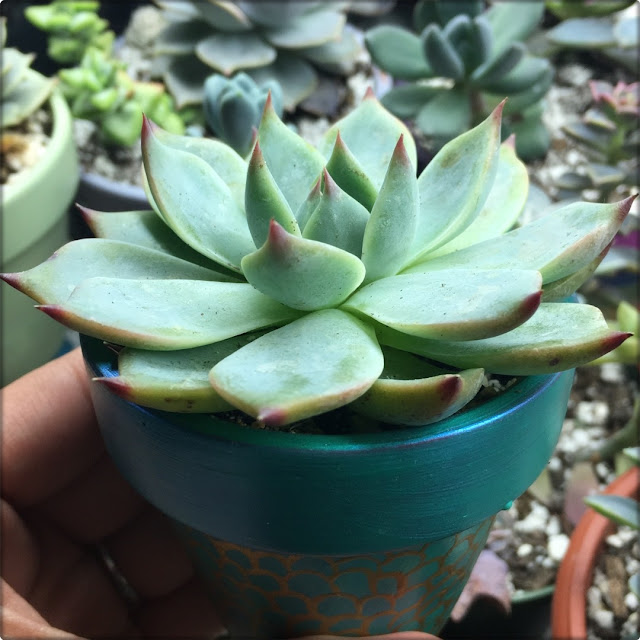Just because you want a plant that is tough doesn’t mean you should settle for one that is less than gorgeous. One that fits into the resilient and striking category is Echeveria. This genus of easy-care succulents has attractive rosette-shaped foliage. If this sounds promising, read on for more echeveria plant information, in particular growing Echeveria parva.
Echeveria Plant Information Echeveria parva succulents are great little garden survivors. They tolerate heat, drought and also cold snaps, yet are also lovely, with their red-edged rosettes and dramatic flower stalks. According to echeveria plant information, the ‘parva’ species is difficult to find in commerce, but it is worth the effort. Parva offers unique coloring, with icy blue-green rosettes trimmed in blood red accents. ‘Parva’ means dwarf in Latin, so it makes sense that Echeveria parva succulents are a small variety.
However, the rosettes are extremely dense, to the extent that they are compared to cabbages. The succulents also delight with golden, bell-shaped flowers on long stems. They are popular with both bees and hummingbirds. Growing Echeveria Parva If you want to start growing these succulents outdoors, you’ll have to live in a fairly warm area.
Echeveria parva plants are cold hardy only in U.S. Department of Agriculture plant hardiness zones 9 through 11. On the other hand, it’s easy to grow succulents in containers in any region. You just have to remember to bring them into a protected area in winter.
Echeveria parva care starts with planting these lovely rosettes in a full sun location. If you are doing container plants, place them outside in summer in a sunny spot. Regular irrigation is an important part of care for echeveria parva plants. Water regularly but not too often during the growing season.
As winter approaches, cut down on irrigation. The very worst thing in terms of Echeveria parva care is giving your succulents wet feet in winter. If you love your echeveria succulents, you may long for more. This is not a problem.
The plants tend to clump and form pups. These can be removed and replanted to start a new plant. Echeveria propagates easily from cuttings too.
It is a popular and considerate idea to gift wedding guests with a small token of appreciation for their attendance. One of the hottest gift ideas of late has been a small potted succulent. The ideal succulents for this purpose are Chroma echeveria plants. It might even be nice to include a small card with a description of what an Echeveria ‘Chroma’ is, growing Chroma echeveria and succulent care for your guests to take home with them.
What is Echeveria ‘Chroma’? Chroma echeveria plants are hybrid succulents created in California. They are comprised of a small rosette of up to 3 inches (7.5 cm.) across, which makes them the perfect size for a take-away gift. Their diminutive size isn’t their only selling point; they also have lovely shiny, deep rose to maroon foliage that can complement the bridal party’s colors. Echeveria ‘Chroma’ Info From the Crassulaceae family, Chroma succulents are only cold hardy to 20-30 F. (-7 to -1 C.), which means they can be successfully grown in USDA zones 9-11 outside.
All other zones should grow Chroma as a houseplant. The parent plant, Echeveria, is among one of the most colorful of the succulents. It can grow quite large with thick brightly hued leaves. Hailing from Mexico and Central America, echeveria blooms with yellow, orange, red or pink bell-shaped blossoms on long stems. Chroma Succulent Care Succulents are easy to grow as long as you don’t overwater them. Remember that succulents hold water in their thick fleshy leaves.
Do not water them until the soil is dry to the touch. Overwatering can lead to rot of both leaves and roots. When growing Chroma echeveria, use a succulent/cactus potting soil that is porous and well-draining. Be sure that the container has adequate drainage holes. Situate the succulent in an area with plenty of light. As the lower leaves dies back, be sure to remove them, as they can be havens for pests such as mealybugs. When the plant outgrows its pot, allow the soil to dry out and then gently remove the succulent.
Remove any rotted or dead roots and leaves. Treat any cuts with a fungicide. Then repot Chroma in a larger pot, spreading the roots out as you backfill with soil. Let the succulent stay dry for about a week and acclimate, then water it lightly as usual.
source
source
,
Random Post
https://succulents-garden.blogspot.com/search/label/DIY
Recent-Post
10/recent/post-list
Popular Posts
Recent Posts
8/recent/post-list
Created By SoraTemplates | Distributed By Blogger Templates




